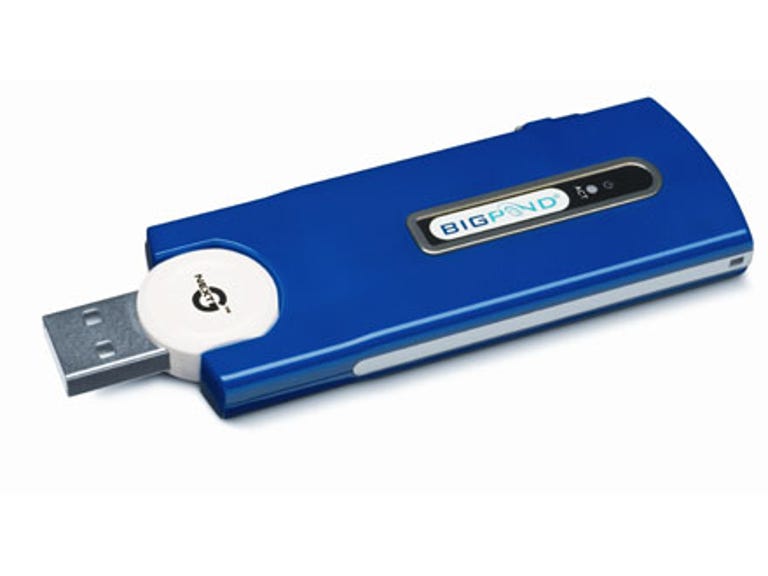 Why You Can Trust CNET
Why You Can Trust CNET BigPond Next G Wireless Broadband USB Mobile Card review: BigPond Next G Wireless Broadband USB Mobile Card
Telstra's Next G USB modem pushes the wireless broadband needle past 2Mbps, making it a better choice than its sibling PC Card in most (but not all) situations.
Following the launch of its Next G network and matching PC Card, Telstra's rollout of wireless broadband hardware continues with the slim BigPond Next G Wireless Broadband USB Mobile Card.
The Good
The Bad
The Bottom Line
That moniker is a muddle as well as a mouthful, with only the tell-tale inclusion of 'USB' to set it apart from the similarly-named PC Card version. To be honest, this product isn't really a 'card' per se -- but we can appreciate that 'BigPond Next G Wireless Broadband USB Dongle Thing' would lack a little something in the marketing stakes.
Design
It's a compact yet study design engineered by local manufacturers Maxon, who also built Telstra's recently-released Next G wireless desktop modem and have a Next G ExpressCard modem due mid-year.
Drivers and client software are provide for Windows 2000 and XP, although Maxon tells us that drivers for Vista and Mac OS X are in development.
Also supplied is a short (10cm) stiff USB extension lead, in case the protruding edges of the modem's case prevent other devices such as mice or memory keys being plugged into adjacent USB ports.
Features
This makes the USB modem worthy of close consideration even if your laptop can accept a PC Card, in addition to its being the only Next G option for newer notebooks sporting an ExpressCard slot.
Like its PC Card sibling, the modem will fall back to GSM if you wander into a low-signal or no-signal area. The device can also be taken overseas, where it roams onto the 850MHz 3G networks of Telstra partners in 33 countries, but the surcharge of AU$15 per Mb makes for a significant ouch factor.

We can safely repeat the same bouquets and brickbats as directed at the software and manual of the BigPond Next G PC Card. Telstra's BigPond Connection Manager 2 provides a user friendly front-end and setup routine, although it makes every effort to hijack your browser's home page and branding. The manual, on the other hand, is a superbly informative effort written in plain English.
Performance
Even allowing for the most ideal conditions -- and few cities or offices get close to that -- there are enough overheads in data transmission to shave a fair whack off the maximum theoretical speed. The available bandwidth and speed will also be reduced depending on how many users are sharing each Next G cell.
Testing the modem in and around the Sydney and North Sydney CBD zones, from outdoor cafes to inside a city office block, we enjoyed solid signals at an average of 1.8Mbps with peaks to 2.2Mbps. This was well clear of the results for the BigPond Next G PC Card in those same areas, where the average was closer to 1.2Mbps.
Curiously, the USB modem lagged well behind the PC Card when tested in a North Sydney apartment. The card clocked close to 1Mbps while the USB modem managed no better than 300Kbps.
We're at a loss to explain this because in all other tests the scoreboard was reversed, unless there's something about mid-range signal locations where the USB modem isn't quite so snappy.
In the end, it only serves to underscore our previous cautions about wireless broadband -- signal strength and quality of service is so reliant on your location that you have to test drive any wireless broadband network in your most visited areas before you sign up.
Telstra offers a 10-day trial of BigPond Wireless Broadband with a refund of the card's cost "if there's no or poor coverage at your preferred location because it's outside the coverage area or in a black spot".
On top of the AU$299 for the USB modem is the cost of usage plans. These are based either time or volume, with two speed levels -- G Fast is limited to 256Kbps, while Super G Fast ratchets between 550-1500Kbps.
The entry-level AU$29.95 plan buys you 10 hours of Super G Fast per month. For AU$49.95 per month you can choose between 200MB at G Fast speeds or 20 hours of Super G Fast. Time-based pricing disappears with the AU$79.95 scheme, which delivers 1GB of G Fast or 400MB of Super G Fast. For AU$109.95 you get 1GB of Super G Fast, while AU$199.95 covers 3GB of Super G Fast. Excess usage on either G Fast or Super G Fast is charged at 30c per Mb on usage-based plans and 80c per five minute block on time-based plans.

